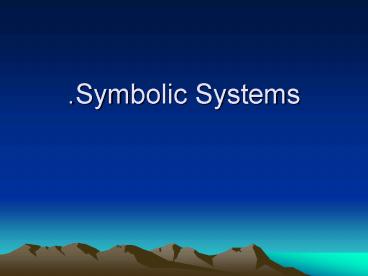'Symbolic Systems PowerPoint PPT Presentation
1 / 22
Title: 'Symbolic Systems
1
.Symbolic Systems
2
What is Achievement?
- Stuff that is taught in school
- What stuff?
- Why do we teach it?
- Where did it come from?
- What purpose does it serve?
3
Evolution of Culture
- Involves
- Biological evolution Cultural Evolution
- Biological Evolution
- Mainly concerned with brain development
- Cultural Development
- Information transmission
4
Evolution
5
Tree
6
Homo Habilis
Genus Homo Homo Habilis- 2 million years ago,
similar to australopithecines but bigger brain.
Used stone tools Poor estimates of brain size,
between 775cc to 1470cc, average about 700cc
7
Homo Erectus
- Clearly different than Habilis
- Fossils date to 1.5 million years ago
- Larger cranial capacity, average 1100cc (80
modern humans) - Complex tool use, requires planning
- Diet changes
- Cultural transmission but with minimal language
use
8
Homo Sapiens
- Big Brain, dated back to about 200,000 to 100,000
years - Cultural Transmission Ritual, art, myth,
- Fast cultural change
- Why the change?
- LANGUAGE (Lieberman, 1973, 75, 84)
- Culture-decoding cultural signals
9
Language
- Linguistic Adaptation
- Changes in vocal
- apparatus
- Features
- Flexible tongue
- Dropped larynx
10
(No Transcript)
11
(No Transcript)
12
Anatomy
- Larnyx- cartilage containing vocal cords,
vibrates to produce sound - Vocal Tract- connects larnyx to oral cavity
- Speech Articulation
- The smallest units of speech sounds are called
phonemes. One or more phonemes combine to form a
syllable, and one or more syllables to form a
word. - Phonemes can be divided into two groups vowels
and consonants. Vowels are always voiced. - Consonants may be classified according to their
manner of articulation as explosive (p, b, t,
etc.), fricative (f, s, sh, etc.), nasal (m, n,
ng), liquid (r, l), and semivowel (w, y). - Reading Phonemic vs. Whole-word
- Intervention
13
Language Development
- Innate capacity
- Preparedness Sensitivity to outside stimuli
- movie
14
Implications
- Language learning is innate
- Phoneme detection in infancy Movie
- Pre-verbal problem solving
- Tool use (spoon)
- Gestural communication
- Pointing
- Modeling
- Brain Expansion
- Prefrontal lobe expansion for information
coordination - Working memory, supervisory system, hierarchy
formation,
15
Culture
- Language provided symbolic communication,
resulted in cultural change through stages - Stages (Donald, 1991)
- Episodic-situational dependent, event perception
(primate) - Mimetic-intentional, nonlanguage symbolic
gestures - Child pointing (Vygotsky, 1934)
16
culture
- 3. Mythic-complete language to transmit ideas
through auditory representations. Permitted
transmission of conceptual models of the world
(i.e. myth), collectively held metaphors to
regulate activity. - -Myths to integrate multiple episodes was
contingent on an efficient symbol-making
apparatus (phonological adaptation) through
spoken language
17
External symbolic culture
- 4. Theoretic Culture
- Visuo-Graphic invention- symbolic use of graphic
devices. - First recorded approximately 40,000 years ago.
- Pictorial/ornamental 25,000, Writing 6,000
- Of thousands of languages, 1/10 develop writing
- First Writing used for trade in Mesopotamia
18
Graphic Language
- Pictographs
- Ambiguous
- Require learning thousands symbols
- Writing-translation/maping of phonetic oral word
structure into graphemes. - Alphabet- A, B, C, D.
- Alpha ? North Semitic/Egyptian oxhead ? Hebrew
aleph ? alpha ? A - Pictographic Origin
19
Graphic language
- If spoken, then written, then re-spoken
- External Symbolic Storage
- Language representation stored on non-biological
device (e.g. papyrus, paper, computer) - Freed from biological limitation, - 7(hardware
change) - Allows humans to accumulate experience across
time. Stability in adaptation - Once cultural privilege.
20
Current Culture
21
Achievement
- External symbol system
- Individuals with reading, writing, and
arithmetic skills are like computers with
networking capabilities they are able to plug
into whatever information source is available
22
Importance of Literacy
- Fundamental to todays society
- Bus schedule, medication dosage, etc.
- U.S. Adult Literacy
- Importance for measurement tools

